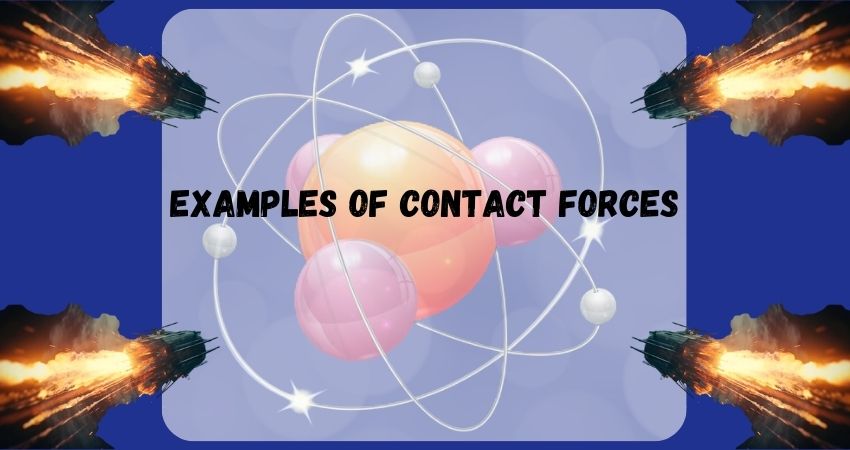Contact forces are forces that act between two objects that are physically touching each other. Discover examples of contact forces in action. From friction between surfaces to tension in a rope, learn about the various ways that contact forces shape our daily experiences. Read on to explore real-world examples of these fundamental physical interactions. They are responsible for most of the interactions we experience in daily life
- Reaction Force: When an object rests on the surface, it experiences a reaction force. Picture a book peacefully residing on a table; that’s the result of the interaction between the book and the table – a subtle yet fundamental contact force at work.
- Tension: An object being stretched undergoes a tension force. Imagine a cable holding a ceiling lamp in place – the force at play is tension. It’s the silent strength that keeps things in balance, literally hanging by a thread.
- Friction: As two objects slide past each other, they encounter friction forces. Consider a box gracefully sliding down a slope. Friction is the invisible hand that ensures a controlled descent. It’s so ubiquitous that without it, the simple act of walking would become an elaborate dance of slips and slides.
- Air Resistance: Objects moving through the air contend with air resistance. Think of a skydiver gracefully descending – the force they feel is the resistance offered by the air. It’s a testament to how even the atmosphere participates in the dance of contact forces.
Definition of Contact Forces
Contact forces are forces that occur when two objects come into physical contact with each other. These types of forces can be observed in our daily lives when we push, pull, or lift objects. Examples of contact forces include friction, tension, normal force, and air resistance. These forces are crucial in understanding how objects move and interact with each other in the physical world.
Importance of Contact Forces in Daily Life
Think of contact forces as the backstage crew of our daily drama. From opening a door to riding a bike, understanding these forces unveils the physics behind our seemingly ordinary actions.
Types of Contact Forces
Types of contact forces are given below;
Reaction Force
Ever high-fived a friend? That’s reaction force in action. It’s the force exerted in response to an action, and it’s everywhere, from bouncing on a trampoline to squishing a stress ball.
Examples of Reaction Force
- High-fives: Your hand meets another with a satisfying clap.
- Jumping on a trampoline: The surface pushes you back up.
Tension
Tension is the silent force when you pull a rubber band or dangle a yo-yo. It’s that taut feeling when opposing forces are at play.
Examples of Tension
- Stretching a rubber band: Feel the tug as you pull.
- Using a yo-yo: The string stays taut as the yo-yo swings
Friction
Meet friction, the force that makes you slide on a polished floor or grip a pen. It’s the reason you don’t turn into a human sled every time you take a step.
Examples of Friction
- Walking on ice: Your shoes struggle for traction.
- Rubbing hands together: Friction warms you up on a chilly day.
Air Resistance
Ever stuck your hand out of a car window? That invisible push against your hand is air resistance. It’s what slows down a falling leaf or makes your hair dance in the wind.
Examples of Air Resistance
- Sticking your hand out of a car window: The force pushing against your hand.
- Parachute descent: It slows your fall with style.
Contact Forces and Newton’s Third Law of Motion
Newton knew a thing or two about forces. His third law states that for every action, there’s an equal and opposite reaction. So, when you push a wall, the wall pushes back with equal force. It’s the cosmic way of saying, “No pushing without pushing back!”
- Walking or Running: The friction between our feet and the ground is a contact force that propels us forward. Without it, our daily commute would resemble a comical attempt at ice skating.
- Writing: The force applied to a pencil while writing is a contact force that leaves its mark on paper. Every stroke is a dance between the force exerted and the resistance offered, creating the art of written expression.
Contact Forces Examples
Here are the most interesting examples of contact forces:

- High-fiving a friend: The joyous act of high-fiving a friend involves a contact force—the satisfying clap of hands coming together, creating a moment of connection and celebration.
- Jumping on a trampoline: When you leap onto a trampoline, you’re not defying gravity alone. The surface of the trampoline exerts a reaction force, propelling you back up into the air for that weightless feeling.
- Stretching a rubber band: As you elongate a rubber band, you’re experiencing tension, a contact force that increases as the rubber band stretches, creating a potential energy ready to snap back into action.
- Using a yo-yo: The simple act of using a yo-yo involves tension in the string. As the yo-yo descends, the string remains taut, creating a force that keeps the yo-yo connected to your hand.
- Walking on ice: Take a step on an icy surface, and you’ll encounter friction in action. The resistance between your shoes and the icy ground determines how slippery or stable your walk will be.
- Rubbing hands together: On a chilly day, the friction generated by rubbing your hands together not only warms you up but also showcases the contact force that arises from the surfaces of your palms coming into contact.
- Sticking your hand out of a car window: Feel the wind pushing against your hand? That’s air resistance, a contact force that increases with speed and gives you a sense of the forces at play during a breezy drive.
- Parachute descent: Jumping with a parachute? The drag force of air resistance slows down your descent, turning a free fall into a controlled and dramatic descent.
- Lifting a suitcase: When you lift a heavy suitcase, the Earth pushes back with an equal and opposite force. It’s the contact force that reminds you that gravity is always in play.
- Pushing a pen on paper: Writing or drawing involves overcoming the resistance of friction between the pen and paper, turning ideas into tangible expressions.
- Swimming against a current: In water, the force you feel pushing against you is water resistance, a contact force that makes swimming against a current a challenging yet invigorating experience.
- Working with clay: The joy of molding clay involves hands meeting resistance. The force applied shapes the clay into a creation, highlighting the intimate connection between force and artistry.
- Soccer kick: A powerful soccer kick is a dynamic interplay of forces. Your foot meets air resistance, showcasing the collision of strength and opposing forces on the field.
- Sliding a glass: As you slide a glass across a countertop, friction prevents it from careening off the edge, demonstrating the subtle but crucial role of contact forces in everyday actions.
- Pedaling uphill on a bicycle: Climbing a hill on a bicycle is a testament to overcoming both friction and gravity, where your pedaling force must conquer the resistance of the terrain.
- Squeezing a stress ball: The satisfaction of squeezing a stress ball is not just psychological; it’s the contact force of the ball pushing back against your hand, providing a tangible outlet for stress relief.
- Closing a door: Applying force to close a door involves overcoming the resistance provided by the hinges and latch, a tactile example of contact forces at work in our daily environments.
- Using a hammer and nail: Driving a nail into wood with a hammer requires exerting force against the resistance of the wood, showcasing the fundamental nature of contact forces in construction and craftsmanship.
- Squeezing toothpaste from a tube: The everyday act of squeezing toothpaste from a tube involves overcoming the resistance of the paste within, a small yet familiar encounter with contact forces.
- Turning a wrench: Whether tightening a bolt or fixing a leak, turning a wrench is a practical application of contact forces, where your force overcomes the resistance in the mechanics of the tool and the object being worked on.
These examples showcase how contact forces are an integral part of our daily experiences, influencing everything from simple gestures to more complex activities.
Understanding contact forces is not just for physicists; it’s a key to unlocking the secrets of our daily interactions. From the simplest acts of placing a book on a table to the complex ballet of walking, these forces shape our world in ways both seen and unseen. So, the next time you take a step or write a note, remember – it’s the contact forces that make it all possible.

